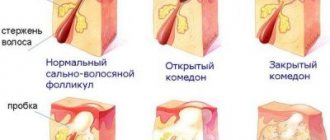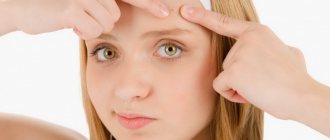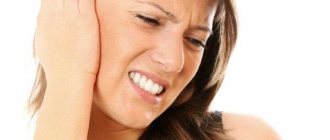Pimples* on the chin: causes
There are quite a few reasons why acne* appears on the chin, and it is difficult to understand them without the help of a specialist. Sometimes laboratory tests are required to find out what exactly caused the rash. The most common causes of acne* in the chin area are [29, 50, 4]:
- hormonal disorders;
- poor nutrition;
- frequent stress, constant emotional stress;
- improper personal hygiene (lack or excess), use of low-quality, comedogenic cosmetics;
- hereditary factors;
- diseases of internal organs (for example, problems with the gastrointestinal tract, genitourinary, endocrine systems);
- mechanical impact (pressure, rubbing).
The habit of constantly touching your face with your hands and using dirty cosmetics can also cause acne.
Pimples* on the chin: which organ may not be working properly?
There is a theory that the location of the rash on the face is associated with disturbances in the functioning of a particular organ. Here are the problems, according to her, that rashes in the chin area indicate [208]:
- hormonal disorders, high levels of male hormones (in women);
- diseases or congestion in the pelvis;
- prostatitis;
- diseases of the endocrine system;
- frequent stress.
There are no scientific studies on how acne* on the chin is related to organs. Therefore, it cannot be said that rashes are a sign of disturbances in the functioning of specific organs or internal systems of the body.
Prevention
Preventing acne on the chin is possible through various measures.
- A special diet based on seasonal fruits and vegetables in combination with fermented milk products;
- Refusal of sweets, caffeine, alcoholic beverages, minimizing the consumption of nuts and eggs, spicy, fatty foods;
- Drink 2 liters of liquid per day - pure water, green tea without sugar, fruit drinks and natural juices;
- Attentive attitude to care, 2 times a week resort to scrubs (in the absence of inflammation) and masks with an antibacterial effect;
- If you are prone to rashes, disinfect your mobile phone with antiseptics, touch your face only with clean hands, use a separate towel;
- Regular intake of multivitamin complexes;
- Applying protective ointments when going outside on frosty days and hot sunny days.
What to do with acne* on the chin?
Let's start with what you shouldn't do if you have acne - squeeze out blackheads*. Painful subcutaneous pimples* often appear in this part of the face. Their extraction can lead to rupture of the follicle and spread of the inflammatory process into the deeper layers of the skin. To prevent this, you need to properly care for your face and contact a specialist to select a treatment method.
Here's what skin care should be like if acne appears on it:
- use only gentle care products, forget about scrubs for a while;
- do not try to dry your skin with alcohol-containing cosmetics, it does not need it;
- don’t forget about moisturizing, even oily skin needs it;
- be sure to wash off your makeup at night, especially if you used a large amount of it to mask rashes;
- use cosmetics that do not contain comedogenic elements;
- review your diet, exclude potentially dangerous foods (milk, sweets, alcohol, fatty foods, etc.)
If you often experience a chin rash, but the disease is now in remission, you can try to reduce the risk of relapse. To do this, follow these recommendations:
- check the expiration date of your cosmetics and its composition, it may contain comedogenic components;
- change tools for applying cosmetics more often or use products to clean them;
- change bed linen every 1-2 weeks;
- use different towels for hands, body and face;
- get rid of the habit of propping your face with your hand, and generally try not to touch it unless necessary.
These tips do not protect you 100% from acne, but they can reduce the likelihood of acne.
The best medicines
On pharmacy shelves you can find many products that allow you to eliminate a rash on your chin at home. Getting rid of internal acne is quite difficult, but with the right medications it is quite possible. The most effective:
- Zinerit is an effective drug from the group of antibiotics. It has a pronounced antiseptic, antibacterial and anti-inflammatory effect. Available in powder form for preparing a suspension. The resulting composition is used for spot treatment of lesions for 4-8 weeks. This time is enough to completely eliminate the defect.
- Baziron AS is a drug that produces a therapeutic effect due to the content of benzoyl peroxide. The substance has antimicrobial, anti-inflammatory and drying properties, helps to get rid of acne, blackheads and comedones for 4 weeks. The medicine is available in the form of a gel for spot treatment of lesions. With prolonged use, it can provoke dry skin, itching, a feeling of tightness, and sometimes an allergic reaction.
- Levomekol is an antibiotic-based ointment with anti-inflammatory properties. Effectively eliminates even small purulent rashes. When applied to a spot, it stimulates the outflow of pus and the capsule breaking out. Used for 10-14 days. Sometimes it provokes allergic reactions, so it is recommended to consult a specialist before starting use.
- Vishnevsky ointment is a powerful remedy against large pimples with signs of suppuration. Used for spot application, it helps relieve acute signs of inflammation within 5-7 days and prevent further spread of the infection and its entry into the blood.
- Curiosin is a gel for external use based on zinc hyaluronate. When used in the affected area, it has an antiseptic effect, stimulates the processes of regeneration and tissue renewal, helps quickly eliminate the rash and prevents recurrence.
How to remove acne* on the chin: using Clindovit® gel
Acne is a chronic disease that cannot be completely cured. The risk of relapse always remains [18]. For mild to moderate acne, Clindovit® gel can be used [6, 18]. It contains clindamycin phosphate [6]. It is an antibiotic that exhibits antimicrobial activity against propionibacteria [6]. Also, after applying Clindovit® gel to the skin, the level of free fatty acids decreases from approximately 14% to 2% [6]. The drug must be used regularly, applied to the skin 2-3 times a day [6].
*acne
Types of acne
Acne is divided according to age into acne of newborns or preschool children, teenage, youthful and later acne. The degree of severity is determined as follows: the face is visually divided in half by a vertical line and the number of all lesions is counted. If there are less than ten of them, then this is the first - mild - stage of the disease. The second degree is characterized by 10-30 acne, the third - 31-40 acne. The latter is considered an extremely severe stage, with more than forty pimples located on one half of the face.
Classification by shape:
- inductive;
- comedonal acne;
- spherical;
- mechanical;
- lightning;
- ordinary.
Juvenile acne usually goes away on its own after all hormonal imbalances in the body have ended. Lightning acne appears and festeres in one day. They are cleaned, but a deep scar or ulcer remains. Mechanical acne occurs due to damage to the skin. Microcysts are called spherical pimples. They can only be removed surgically; such acne cannot be pierced. Comedones are blackheads that usually do not become inflamed. Indurative ones form swelling of adjacent areas of the epithelium; after disappearance, scars remain on the skin.
Symptoms
First of all, redness and small induration appear on the skin. Further development occurs in stages:
- Spread of inflammation.
- Formation of a bump on the chin.
- Accumulation of purulent masses.
The size of the pimple may vary. When pressing on it, painful sensations occur. The formations may be red or white depending on the stage of development.
Why did pustules appear on the face?
Pimples with purulent contents form against the background of a decrease in the protective function of the epidermal barrier.56
Internal causes that can cause the appearance of pimples* and pustules on the face are56:
- temperature irritants;
- skin contamination;
- dryness of the epidermis;
- exposure to aggressive chemicals, etc.
Endogenous causes include56:
- overwork;
- poor nutrition;
- diseases of the digestive system;
- chronic intoxication;
- reduced immunity;
- endocrine disorders.
Weakening of the antibacterial protection of the skin may be associated with autoimmune diseases and diabetes.
Differential diagnosis
It is necessary to differentiate acne:
- With cold herpes. The reason for its development is infection with a virus. Infection with it has a characteristic clinical picture. The disease begins with a general malaise and only then a rash appears on the chin, which clusters around some wound or abrasion.
- With sebaceous gland adenoma. Its development begins in early childhood even before signs of inflammation of the skin of the chin appear.
- With keratosis pilaris. When it forms, there is a keratosis plug in the center of inflammation, but acne does not have one.
- With molluscum contagiosum. It has a depression in the center. The papule itself has a translucent structure.
- With steroid acne. They appear only when taking glucocorticoids. When the drug is discontinued, the skin rashes disappear.
- With flat warts. They have the shape of a papule, which does not differ from the color of the skin. Externally, a wart looks like a thin plaque.
If internal pathologies are suspected, the patient is sent for an extensive diagnostic examination.










